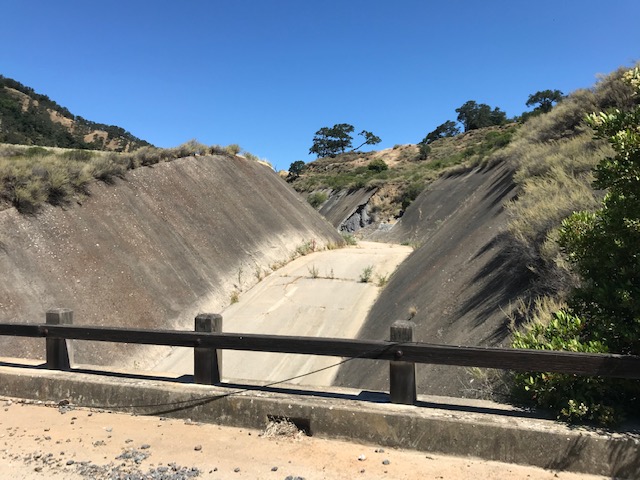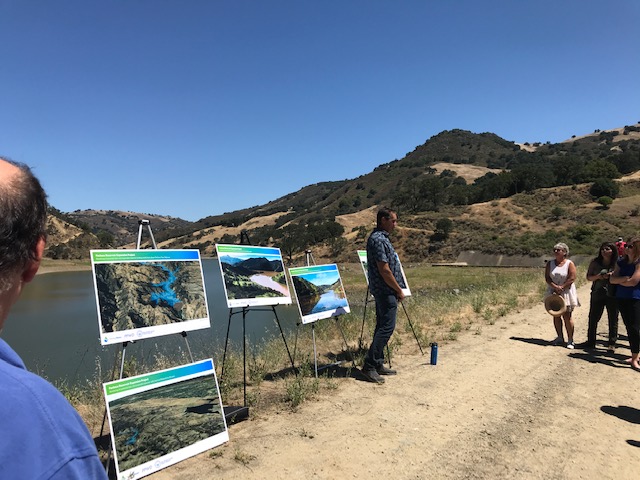 The San Luis Delta Mendota Water Authority held its Thursday, July 11, 2019 board of directors meeting at its Los Banos headquarters. Before the meeting started I had a chance to sample the snacks offered. One of my pet peeves is when you go to an ag based meeting and they serve peanuts and pineapple or something not grown locally. So, today I tried the Nature Valley Sweet & Salty granola bars. One was peanut and the other was almond. The almond rocked. Peanuts are ok but if you want to get serious you have almonds and pistachios.
The San Luis Delta Mendota Water Authority held its Thursday, July 11, 2019 board of directors meeting at its Los Banos headquarters. Before the meeting started I had a chance to sample the snacks offered. One of my pet peeves is when you go to an ag based meeting and they serve peanuts and pineapple or something not grown locally. So, today I tried the Nature Valley Sweet & Salty granola bars. One was peanut and the other was almond. The almond rocked. Peanuts are ok but if you want to get serious you have almonds and pistachios.
Chairman Cannon Michael called the meeting to order at 8:00am. This is, of course, not the regularly scheduled 9:30am start. Today is special. We’re taking buses to San Luis Reservoir and the Pacheco Reservoir after this meeting. Since we have to turn around at Casa de Fruta to get to Pacheco I’m guessing they’re not short buses. But they were, very nice ones with disco lights and such.
Everyone introduced themselves and we saluted the flag together. Under the consent calenda r Tom Birmingham had a change to the minutes and there were a couple of other changes. The consent calendar was approved and CPA Bill Patterson gave the fiscal year 2016 audit report. I don’t’ know why the 2016 instead of the 2018 audit but no the less the report was given by telephone. It was mercifully short and since the finance committee recommended approval the audit was approved.
r Tom Birmingham had a change to the minutes and there were a couple of other changes. The consent calendar was approved and CPA Bill Patterson gave the fiscal year 2016 audit report. I don’t’ know why the 2016 instead of the 2018 audit but no the less the report was given by telephone. It was mercifully short and since the finance committee recommended approval the audit was approved.
Next Frances Mizuno spoke about the 2019 water year Operations & Management rates. Mizuno gave examples based on the allocations from the CVP and related usage. She said the rewinding costs of one of the pumps was more than $1 million but SLDMWA was able to save a little money in the deal. Good for them. There is still a balance and since it’s a good water year the O&M rates are a little cheaper all along the canal. The board approved the proposed O&M rates.
SLDMWA Executive Director Federico Barajas presented the board with the completed 2019 Strategic Plan. He had Martin Rauch, Rauch Communications, give an overview of the plan. This document was 16 pages long but not the fully detailed version. It gives mission and vision statements to set goals and how to implement the tasks to achieve those goals. Some of the topics were exchange and transfer of water, filling key positions and increasing economic development. Directors John Varela and Birmingham both congratulated and commended Rauch and Mizuno for the heavy lifting it took to complete this plan. Birmingham asked how the implementation will be funded. He said the plan includes an ad hoc committee on how to allocate costs to the member agencies. He said it could easily cost more than a million dollars. Since Westlands Water District pays 50 percent of the legislative costs he doesn’t want any misunderstanding that Westlands thinks this is ok. That said he moved to accept the plan and the board agreed. Rauch said he’s worked with hundreds of boards over the more than 30-years he’s been in this game. He said he’s never worked with an agency so motivated to get things done. He complemented SLDM for its willingness to work together. Director Bill Diedrich said a year ago folks in San Luis Delta Mendota were holding their breath in anticipation of which way things could go. Diedrich said he is more confident and optimistic about the agency’s direction than ever. The board adopted the plan. Good for them.
Mizuno next reported there was a traffic accident involving a SLDM vehicle and it is in the agency’s best interest to reject the claim. Not because it was frivolous but because it placed the agency in a better position should there be a lawsuit.
Barajas knocked me over with an announcement that COO Mizuno is leaving. Recruitment for a replacement is now open and there is an August 9th deadline to apply. Wow, what a task. I’m kind of sad because Mizuno has always been honest, prompt and truthful with me. Once in while I’ll bug her with questions and ask she explain the answers as if I was in the 4th grade and she’s been most gracious. But I’m also happy because she deserves a good retirement. Barajas completed his report and said he’s pleased to go on the tour following the meeting.
Scott Petersen reported on legislative activities saying he was able to host a tour of the Jones Pumping Plant for some congressional members. He also said Senator Dianne Feinstein and a member of the House have introduced legislation to extend the WIIN Act. The House introduced a bill to add California to the nutria eradication efforts. I think $17 million worth. Don’t forget Louisiana is paying $6 bounty for a nutria tail. He reported Karla Nemeth was reappointed as Director of the Department of Water Resources. SB 1 was opposed by the Santa Clara Valley Water District as well as Metropolitan WD, so with the exception of East Bay MUD, the water community is united in its opposition to SB 1. Senate Pro Tempore Toni Atkins of San Diego is the author. I’ve been trying to contact her or her staff without success to find out what the heck is going on. SB 1 has all the trappings of political theater. While I would consider Atkins to be a leftist as opposed to a liberal she does have the reputation of understanding and supporting agriculture. So there’s a dichotomy going on here. More when I find out.
Peterson continued saying the re-consultation of the biological opinions will most likely be delayed due to conflicts between the Fish & Wildlife and the National Marine Fisheries about the smelt and the salmon. The NEPA process should move forward while the bureaucrats get their stories straight and things can still come together by the end of this year.
Tom Boardman, now working for Westlands WD gave his report saying the Jones and Banks Plants are either at capacity or near. He said there was a bump in the road with the US Bureau of Reclamation. The Bureau was over conservative this year and the contractors were right on. Now there is a 500,000 a/f projected for San Luis at the end of August – a most inefficient management of the reservoir.
Pacheco Reservoir
Next the Santa Clara Valley Water District’s Chris Hakes (it likes to call itself Valley Water now) gave a brief overview of the Pacheco Reservoir expansion – which is what the tour will be about. The Pacheco Tunnel is the conduit to the San Felipe Division of the CVP. This pipe has an intake higher than the optimal elevation in SLR where it gets its water. That means in the summer algae gets sucked up and the water quality stops the pumping. Some options are raising the San Luis Dam, putting in a treatment plant to deal with the algae or expand the Pacheco Reservoir from 4,000 a/f to 140,000 a/f. This will be a two way street since if Pacheco is full it won’t be drawing from SLR and could even send water back. Next Richard Welch from the  Bureau spoke about the raising BF Sick Dam on San Luis Reservoir. Welch said there is a dam safety modification that can be tied into raising the dam. Since it’s a safety issue it will positively impact the cost/benefit ratio. The dam will be raised eight to 12 feet with another possible 10 feet expansion on top of that. This will add another 120,000 a/f of additional storage. This is four to five years off according to Welch. The beneficiaries will be billed.www
Bureau spoke about the raising BF Sick Dam on San Luis Reservoir. Welch said there is a dam safety modification that can be tied into raising the dam. Since it’s a safety issue it will positively impact the cost/benefit ratio. The dam will be raised eight to 12 feet with another possible 10 feet expansion on top of that. This will add another 120,000 a/f of additional storage. This is four to five years off according to Welch. The beneficiaries will be billed.www
Lastly Valley Water gave a brief video of the existing Pacheco Reservoir and then we got on the bus Gus. Our first stop with the Romero Visitors Center on Highway 152 at the SLR. Some docents from DWR spoke a bit about how the system works. Federal water from Shasta and DWR water from Oroville are pumped into the Delta Mendota Canal and the California Aqueduct respectively and sent to the O’Neals Forebay where it is pumped up into SLR. No mention of cooperative operating agreements, X2 lines or hydro year restrictions or ESA. Welch explained some of what he was saying earlier about the BF Sisk Dam expansion. It was good to hear it while looking at the actual dam. The goal is to construct the seismic safety work at the same time as raising the dam for storage. The seismic work will consist of widening the outside toe and the entire dam while raising its height. That way if an earthquake hits the dam should slump no lower than the raised height. Add another 10 feet on top of that and you have storage. It’s much cheaper and more efficient to do all the work at once. How long and how much? Maybe five years with the pedal to the metal and $1.2 billion.
Next we drove west to Casa de Fruta so the buses could turn around. It’s the first safe place west of the Romero Center. We then went east back toward Los Banos and there was a short left turn lane I’d never seen before that cut across the west bound lanes, through a chain link gate and up a dirt road. We got to the top of the road, crossed a bridge over a broken spillway and parked in an equipment yard. We then walked up the hill to the top of the earthen dam and had a great view of the proposed new dam sight. The new 300 feet high dam will increase the storage from around 5,000 a/f when everything is working right – what is it with spillways these days? – to the 140,000 a/f jewel of a water supply enhancer. The Pacheco Tunnel ends on a  mountain above the current sight across 158. Gravity feed surface water that could be pumped back to SLR if needed. The Pacheco Pass Water District, Valley Water (SCVWD) and the San Benito County Water Agency are the agencies handling this project. Like many if not most surface storage projects the agencies are looking for partners.
mountain above the current sight across 158. Gravity feed surface water that could be pumped back to SLR if needed. The Pacheco Pass Water District, Valley Water (SCVWD) and the San Benito County Water Agency are the agencies handling this project. Like many if not most surface storage projects the agencies are looking for partners.
With the spillway out of commission the rainfed reservoir is allowed to drain down a creek into the gulch running parallel to 152. There is also a pipeline where the water can be diverted to other conveyance infrastructure serving the area. One of the benefits of enlarging Pacheco Reservoir is the usable storage it adds to SLR. Valley Water can off load its CVP and State Project water in Pacheco freeing up space and room to trade, swap and transfer in SLR. Valley Water already scored almost $500 million in the same Prop One deal that so disappointed other projects including Temperance Flat advocates.
After the tour of the Pacheco Reservoir we all went back to Casa de Fruta for lunch. Thanks Valley Water. We then rode back to SLDM headquarters in Los Banos wiser and fuller.
DISCLAIMER OF RESPONSIBILITY; Waterwrights strives to provide his clients with the most complete, up-to-date, and accurate information available. Nevertheless, Waterwrights does not serve as a guarantor of the accuracy or completeness of the information provided, and specifically disclaims any and all responsibility for information that is not accurate, up-to-date, or complete. Waterwrights’ clients therefore rely on the accuracy, completeness and timeliness of information from DAW entirely at their own risk. The opinions expressed in this report are those of the author and do not represent any advertisers or third parties.
ALL RIGHTS RESERVED. Copyright 2019 by Don A. Wright
SAN LUIS & DELTA-MENDOTA WATER AUTHORITY was established in January of 1992 and consists of approximately 2,100,000 acres of 29 federal and exchange water service contractors within the western San Joaquin Valley, San Benito and Santa Clara counties. The governing body of the Authority consists of a 19-member Board of Directors classified into five divisions with directors selected from within each division. The main conveyance is the Delta-Mendota Canal that delivers approximately 3,000,000-acre feet of water within the Authority service area. Of this amount, 2,500,000-acre feet are delivered to highly productive agricultural lands, 150,000 to 200,000-acre feet for municipal and industrial uses, and between 250,000 to 300,000 acre-feet are delivered to wildlife refuges for habitat enhancement and restoration. Chairman: Cannon Michael, Executive Director: Francis Mizuno (Interim), Attorney: Becca Ackroyd.
Email: youtellus@sldmwa.org
P.O. Box 2157 Los Banos, CA. 93635 209/826-9696
































